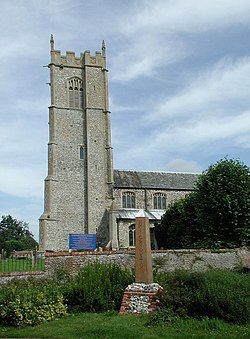Difference between revisions of "Grimston, Norfolk"
(Created page with "{{Infobox town |name=Grimston |county=Norfolk |picture=St Botolph, Grimston, Norfolk - geograph.org.uk - 309218.jpg |picture caption=St Botolph's, Grimston |os grid ref=TF7212...") |
|||
| Line 24: | Line 24: | ||
==Parish church== | ==Parish church== | ||
| − | The parish church, the Church of St Botolph has late Saxon or early Norman origins, largely extended in the 14th and 15th centuries. The church is a Grade I listed building.<ref>{{NHLE| | + | The parish church, the Church of St Botolph has late Saxon or early Norman origins, largely extended in the 14th and 15th centuries. The church is a Grade I listed building.<ref>{{NHLE|1342401|Church of St Botolph|grade=I}}</ref> |
==History== | ==History== | ||
| − | This | + | This village was built on a spring line and a Roman villa, often built at such locations, was found near Watery Lane in the late 19th century.<ref>[http://[www.heritage.norfolk.gov.uk/SingleResult.aspx?uid=MNF3575 Norfolk Heritage Explorer]</ref> Subsequently, Roman villas were found in the neighbouring villages of Gayton Thorpe and Well Hall to the south and Congham and Appleton to the north. Some red bricks from the villas were re-used in the church, on buttresses and on the South Wall. |
Grimston, and particularly the nearby hamlet of [[Pott Row]] were quite significant centres of pottery production from the 11th to 16th centuries, and important suppliers of this to Scandinavia. Grimstonware finds have also been made in Italy and Spain. Pots often had faces carved just under the rim. Some of these can be seen in local museums including the [[Castle Museum, Norwich]]. | Grimston, and particularly the nearby hamlet of [[Pott Row]] were quite significant centres of pottery production from the 11th to 16th centuries, and important suppliers of this to Scandinavia. Grimstonware finds have also been made in Italy and Spain. Pots often had faces carved just under the rim. Some of these can be seen in local museums including the [[Castle Museum, Norwich]]. | ||
Latest revision as of 18:58, 29 August 2023
| Grimston | |
| Norfolk | |
|---|---|
 St Botolph's, Grimston | |
| Location | |
| Grid reference: | TF721224 |
| Location: | 52°46’19"N, 0°32’60"E |
| Data | |
| Population: | 1,980 (2011) |
| Post town: | King's Lynn |
| Postcode: | PE32 |
| Local Government | |
| Council: | King's Lynn and West Norfolk |
Grimston is a village in Norfolk, in the north-west of the county, six miles north-east of King's Lynn. The 2011 census recorded a population of 1,980.
The village is a few miles away from the Royal family's residence at Sandringham House.
Name
Grimston is a mixture of Old English and Old Norse words. Other place names with this formulation are called 'Grimston Hybrids'.[1] Grim is an alternative name for Odin, the Norse god, as well as being a commonly used personal name,[2] and 'ton' is from the Anglo-Saxon word for town or village.
Parish church
The parish church, the Church of St Botolph has late Saxon or early Norman origins, largely extended in the 14th and 15th centuries. The church is a Grade I listed building.[3]
History
This village was built on a spring line and a Roman villa, often built at such locations, was found near Watery Lane in the late 19th century.[4] Subsequently, Roman villas were found in the neighbouring villages of Gayton Thorpe and Well Hall to the south and Congham and Appleton to the north. Some red bricks from the villas were re-used in the church, on buttresses and on the South Wall.
Grimston, and particularly the nearby hamlet of Pott Row were quite significant centres of pottery production from the 11th to 16th centuries, and important suppliers of this to Scandinavia. Grimstonware finds have also been made in Italy and Spain. Pots often had faces carved just under the rim. Some of these can be seen in local museums including the Castle Museum, Norwich.
Outside links
| ("Wikimedia Commons" has material about Grimston, Norfolk) |
References
- ↑ "British Library". http://www.bl.uk/learning/langlit/changlang/activities/lang/vikings/vikinglang.html.
- ↑ "University of Glasgow - Research - Research units A-Z - eSharp - Issues - 2 (Spring 2004): Trailblazing - Yokota". https://www.gla.ac.uk/research/az/esharp/issues/2/yokota/.
- ↑ National Heritage List 1342401: Church of St Botolph (Grade I listing)
- ↑ [http://[www.heritage.norfolk.gov.uk/SingleResult.aspx?uid=MNF3575 Norfolk Heritage Explorer]